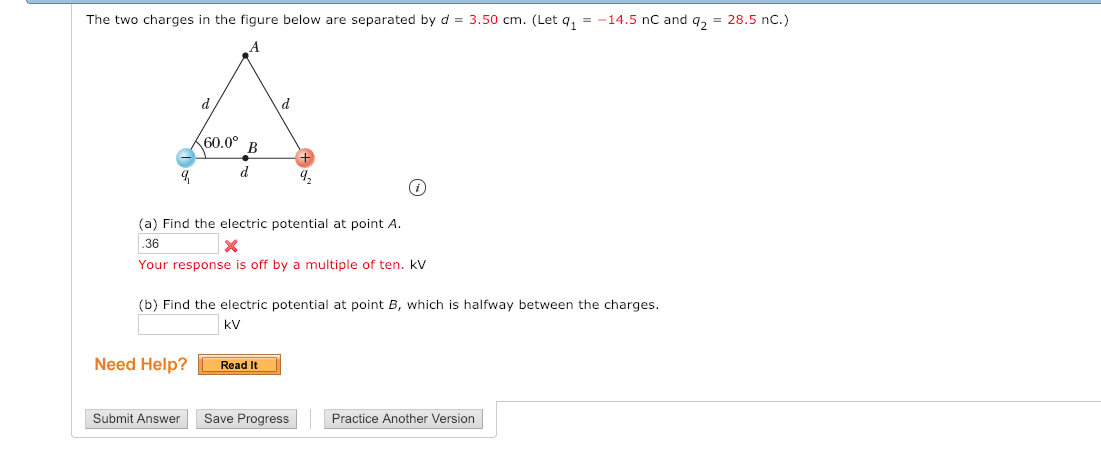The two charges in the figure below are separated by d 3.50 cm. (Let q114.5 nc and q2 28.5 nC.) 60.0° 9 (a) Find the electric potential at point A. 36 Your response is off by a multiple of ten. kV (b) Find the electric potential at point B, which is halfway between the charges. kV Need Help? Read It Submit Answer Save Progress Practice Another Version
The two charges in the figure below are separated by d 3.50 cm. (Let q114.5 nc and q2 28.5 nC.) 60.0° 9 (a) Find the electric potential at point A. 36 Your response is off by a multiple of ten. kV (b) Find the electric potential at point B, which is halfway between the charges. kV Need Help? Read It Submit Answer Save Progress Practice Another Version
College Physics
10th Edition
ISBN:9781285737027
Author:Raymond A. Serway, Chris Vuille
Publisher:Raymond A. Serway, Chris Vuille
Chapter16: Electrical Energy And Capacitance
Section: Chapter Questions
Problem 12P: The two charges in Figure P16.12 are separated by d = 2.00 cm. Find the electric potential at (a)...
Related questions
Question

Transcribed Image Text:The two charges in the figure below are separated by d 3.50 cm. (Let q114.5 nc and q2 28.5 nC.)
60.0°
9
(a) Find the electric potential at point A.
36
Your response is off by a multiple of ten. kV
(b) Find the electric potential at point B, which is halfway between the charges.
kV
Need Help? Read It
Submit Answer Save Progress Practice Another Version
Expert Solution
This question has been solved!
Explore an expertly crafted, step-by-step solution for a thorough understanding of key concepts.
This is a popular solution!
Trending now
This is a popular solution!
Step by step
Solved in 5 steps with 4 images

Recommended textbooks for you

College Physics
Physics
ISBN:
9781285737027
Author:
Raymond A. Serway, Chris Vuille
Publisher:
Cengage Learning

College Physics
Physics
ISBN:
9781305952300
Author:
Raymond A. Serway, Chris Vuille
Publisher:
Cengage Learning


College Physics
Physics
ISBN:
9781285737027
Author:
Raymond A. Serway, Chris Vuille
Publisher:
Cengage Learning

College Physics
Physics
ISBN:
9781305952300
Author:
Raymond A. Serway, Chris Vuille
Publisher:
Cengage Learning


Physics for Scientists and Engineers: Foundations…
Physics
ISBN:
9781133939146
Author:
Katz, Debora M.
Publisher:
Cengage Learning

Principles of Physics: A Calculus-Based Text
Physics
ISBN:
9781133104261
Author:
Raymond A. Serway, John W. Jewett
Publisher:
Cengage Learning

Physics for Scientists and Engineers, Technology …
Physics
ISBN:
9781305116399
Author:
Raymond A. Serway, John W. Jewett
Publisher:
Cengage Learning